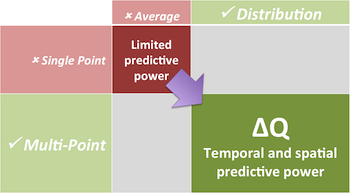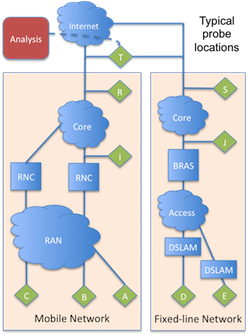Network measurement
Traditional approaches to network measurement start from averaged data captured at isolated points in the network. This process loses critical fidelity, and all attempts to exploit this data inherently require unsound inference techniques, however sophisticated the machine-learning applied.
This results in poor capacity planning choices, unmanaged quality hazards, and unplanned capacity upgrades.

In contrast, we combine measurements at multiple points to collect full distributions of instantaneous packet loss and delay.
Using advanced analysis techniques, we can extract strong proxies for the user experience, called ∆Q.
As a result, we can isolate causes of performance issues and ensure extra capacity is only targeted where it will create value.
NetHealthCheck™ for network operators
Operators need performance monitoring providing:
- Incontestable evidence of the performance of the network;
- Early warning of failure to deliver to specified requirements;
- Evidence to justify capacity investment;
PNSol does this with 'NetHealthCheck':
- Deploying probes at key points on typical end-to-end paths;
- Measuring packet flow performance along the paths;
- Analysing the results;
- Reporting anomalies;
- Providing real-time visibility.
This approach is the basis for Broadband Forum standard TR-452.1
.
NetHealthCheck gives quantitative answers to:
How cost-effective is the network?
- Is the architecture appropriate?
- Are the network assets being fully used?
- Are there loading issues?
- Are the configurations consistent with performance goals?
- Is the capacity planning process effective?
What Quality of Experience does it deliver?
- Does it meet the requirements of the services and applications?
- If not, what are the impairments? Where are they occurring?
- What new services could be supported? What would be the impact on existing services if they were rolled out?

